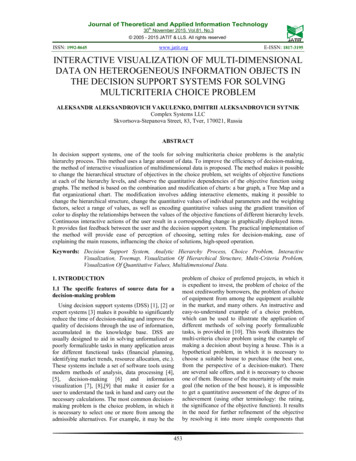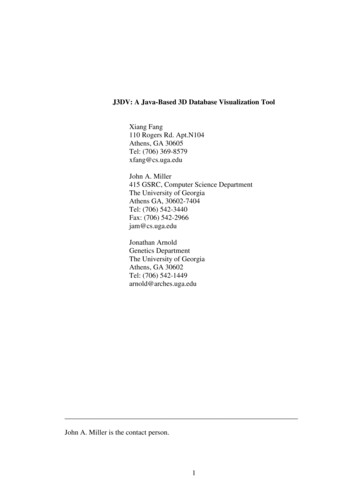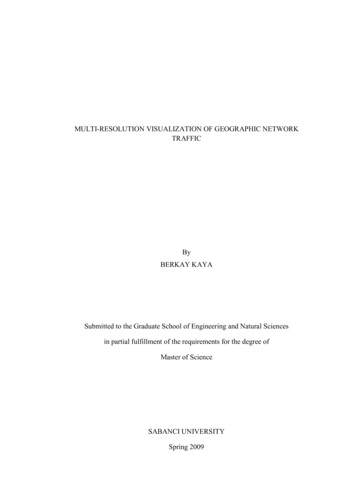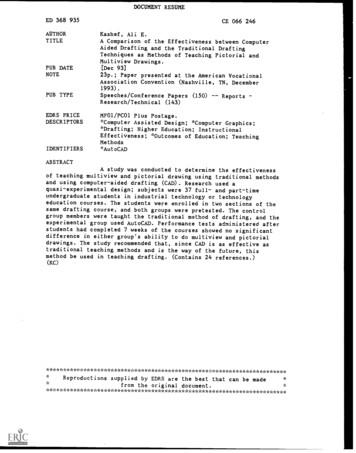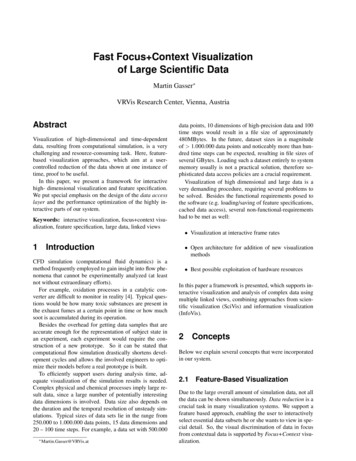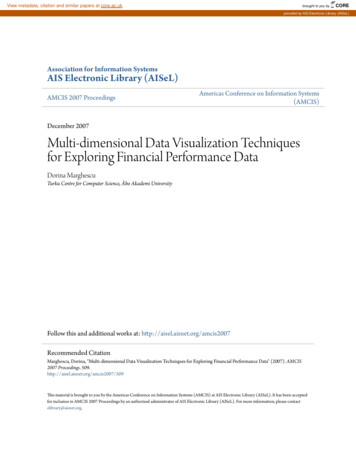
Transcription
View metadata, citation and similar papers at core.ac.ukbrought to you byCOREprovided by AIS Electronic Library (AISeL)Association for Information SystemsAIS Electronic Library (AISeL)AMCIS 2007 ProceedingsAmericas Conference on Information Systems(AMCIS)December 2007Multi-dimensional Data Visualization Techniquesfor Exploring Financial Performance DataDorina MarghescuTurku Centre for Computer Science, Åbo Akademi UniversityFollow this and additional works at: http://aisel.aisnet.org/amcis2007Recommended CitationMarghescu, Dorina, "Multi-dimensional Data Visualization Techniques for Exploring Financial Performance Data" (2007). AMCIS2007 Proceedings. 509.http://aisel.aisnet.org/amcis2007/509This material is brought to you by the Americas Conference on Information Systems (AMCIS) at AIS Electronic Library (AISeL). It has been acceptedfor inclusion in AMCIS 2007 Proceedings by an authorized administrator of AIS Electronic Library (AISeL). For more information, please contactelibrary@aisnet.org.
MULTIDIMENSIONAL DATA VISUALIZATION TECHNIQUESFOR EXPLORING FINANCIAL PERFORMANCE DATADorina MarghescuTurku Centre for Computer Science, FinlandÅbo Akademi University, Dept. of IT, Finlanddorina.marghescu@abo.fiAbstractIn this paper, we review nine visualization techniques that can be used for visualexploration of multidimensional financial data. We illustrate the use of these techniquesby studying the financial performance of companies from the pulp and paper industry.We also illustrate the use of visualization techniques for detecting multivariate outliers,and other patterns in financial performance data in the form of clusters, relationships,and trends. We provide a subjective comparison between different visualizationtechniques as to their capabilities for providing insight into financial performance data.The strengths of each technique and the potential benefits of using multiple visualizationtechniques for gaining insight into financial performance data are highlighted.Keywords: multidimensional data visualization techniques; financial performance;financial data visualizationIntroductionMany novel visualization techniques have been developed in the fields of information visualization (Card et al.1999) and visual data mining (Keim 2002). However, the research literature concerning the use of visual data mining forgaininginsight into financial data is relatively sparse, despite the fact that this technological approach is suitable for bothfinancial data and business users. Financial data are very complex due to their high dimensionality, large volume anddiversity of data types. Business users are demanding straightforward visualizations and task-relevant outputs, due to the timeand performance constraints under which they work (Kohavi et al. 2002).In this paper, we review nine visualization techniques that are suitable for representing multidimensional data. Theaim is to examine the extent to which they are capable of providing insight into financial performance data. In particular, wefocus on the problem of financial benchmarking, which is concerned with comparing the financial performance ofcompanies.The approach consists of the following steps. First, we formulate the financial benchmarking problem in terms ofbusiness questions and associated data mining tasks. Second, we investigate the capabilities of each visualization technique insolving the derived data mining tasks and uncovering interesting patterns in data. Third, we compare the visualizationtechniques from three different perspectives such as: 1) the capability of the techniques to uncover interesting patterns in thedata (task fitness); 2) the capability to visualize data items or data models; and 3) the type of data processed (i.e., original dataor normalized data).
Marghescu, Multidimensional Visualization Techniques for Financial Performance DataThe analysis highlights the strengths of each technique and the potential benefits of using multiple techniques forexploring financial data. In this paper, we do not address the interactive capabilities of the visualization techniques.The paper is organised as follows. In the next section, we outline the problem of financial benchmarking, describethe dataset to which we applied the visualization techniques, and derive the business questions and data mining tasks. InSection three, we describe nine multidimensional data visualization techniques and highlight their capabilities for solving thederived data mining tasks. Section four provides a subjective comparison of the techniques and discusses the results. Weconclude with final remarks and future work ideas.The problem of financial benchmarkingOne of the problems that business intelligence people are confronted with nowadays is performing comparisons ofcompanies’ financial performance. This problem of comparing financial performance of companies is known as financialcompetitor benchmarking (Eklund 2004). The problem is non-trivial since many variables (financial ratios) must beconsidered. One part of the problem is choosing the ratios to be used when describing the financial performance of acompany. Eklund (2004) proposed a model for financial competitor benchmarking in the pulp and paper industry, with sevenfinancial ratios as a basis for companies’ performance comparison, and the Self-Organizing Map (SOM) as the method fordata analysis. In this paper, we build on the mentioned research to explore the use of other visualization techniques forgaining insight into financial data.Illustrative DatasetThe dataset analysed in this paper is a subset of a dataset whose collection process including variable and companyselection are described by Eklund (2004). The data values are entirely based on the information obtained from companies’financial reports available on the Internet.The data refer to 80 companies that function in the pulp and paper industry worldwide, observed during 1997 and1998. A total of 160 observations are analysed. The dataset contains seven numerical variables, namely seven ratios thatcharacterize the financial performance of companies in the pulp and paper industry. The ratios are grouped in four categories:profitability (Operating Margin, Return on Equity, and Return on Total Assets), solvency (Interest Coverage, Equity toCapital), liquidity (Quick Ratio), and efficiency (Receivables Turnover). In the following, we use acronyms when referring toany of the financial ratios (that is, OM, ROE, ROTA, IC, EC, QR, and RT respectively). The dataset contains threecategorical variables: companies’ name, region (Europe, Northern Europe, USA, Canada and Japan), and year (1997 or1998). The choice of this particular dataset was due to the availability of the dataset, and to its suitability for data mining(e.g., cluster detection, cluster characterization, class characterization, outlier detection, and dependency analysis).Business Questions and Data Mining TasksAccording to Soukup and Davidson (2002), in order to use information visualization for solving a business problem,the problem should be translated in terms of business questions and further into visualization or data mining tasks. For theproblem of financial benchmarking we have derived the business questions and data mining tasks as follows:a) Outlier detection: Do the data contain outliers or anomalies? Are there any companies that show unusual values offinancial ratios?b) Dependency analysis: Are there any relationships between variables?c) Data clustering: Are there clusters (groups of companies with similar financial performance) in the data? How manyclusters exist?d) Cluster description: What are the characteristics of each cluster?e) Class description: Are there any relationships (common features) among companies located in one region or another?What are these common features?f) Comparison of data items: Compare two or more companies with respect to their financial performance.For the task f), we have chosen three companies to be compared according to their financial performance in 1998:Reno de Medici, Buckeye Technologies, and Donohue. For Reno de Medici we look also at its evolution from 1997 to 1998.These companies are identified on the graphs using the letters A, B, C, and D, respectively. Table 1 presents the financialratios of these companies.2
Marghescu, Multidimensional Visualization Techniques for Financial Performance DataTable 1. Financial ratios of the companies chosen for comparisonRegionOMROEROTA ECQRCompanyId. YearReno de Medici 1997A1997Europe4.02-15.38 0.6427.94 1.29Reno de Medici 1998B1998Europe6.75.345.2728.19 1.03Buckeye technologies 1998 C1998USA19.42 38.9616.21 20.91 1.36Donohue 1998D1998Canada21.24 17.9615.92 46.35 ional data visualization techniquesBecause our dataset is tabular data, that is, the rows represent records and the columns represent attributes ordimensions of data, and the data has more than two dimensions, we selected multidimensional data visualizations for analysis(Hoffman and Grinstein 2002). The multidimensional data visualization techniques that are reviewed in our paper aremultiple line graphs, permutation matrix, survey plot, scatter plot matrix, parallel coordinates, treemap, PrincipalComponents Analysis, Sammon’s mapping, and the Self-Organizing Maps. In the following, we apply these visualizationtechniques on the financial performance data and highlight their capabilities for answering the business questions and datamining tasks formulated in the previous section. Due to page limitations, we are only discussing two to three ratios for eachtechnique. A complete discussion can be found in Marghescu (2007).Multiple line graphsLine graphs are used for one dimensional data. On the horizontal axis (Ox) the values are not repeated (e.g., time orthe ordering of the table). The vertical axis (Oy) shows the values of the variable of interest. Multiple line graphs can be usedto show more than two variables or dimensions (x, y1, y2, y3, etc.).Figure 1 shows line graphs for two ratios (OM and ROE), observed in 1997 and 1998. The companies are mapped tothe horizontal axis, in the order of appearance in the data table. The graph presents companies from different regions (Europe,Northern Europe, USA, Canada and Japan) in different colours, facilitating the characterization of companies from oneregion or another. By positioning the two years of data one under the other, one can follow the evolution of some company’sfinancial ratios, and make comparisons between companies’ financial states.4020OM 1997 0-2050 0A80BOM 1998CDCD0-5010080ROE 1997 500-50100 0ROE 1998 500-5080A80BEuropeN. EuropeUSACanadaJapanFigure 1 Multiple line graphsThis graph also facilitates the detection of outliers or anomalies in the data, for example, the very low and very highvalues of ROE for three of the companies, which were further removed from the dataset. By highlighting the companies to becompared, one can see the differences and similarities among them.3
Marghescu, Multidimensional Visualization Techniques for Financial Performance DataPermutation 5060.8440.9721.101.23-18.63-38.50ROTAThe permutation matrix is a special type of bar graph described by Bertin (1983). In a permutation matrix, each datadimension is represented by a bar graph in which the heights of the bars represent the data values. The horizontal axes of allbar graphs have the same information (e.g., the time or ordering of the data table). The below average data values arecoloured black, and the above average data values are coloured white. A green dashed line plotted over the data representsthe average value of each dimension. Implementations of permutation matrixes allow the interactive changing of the order ofthe records for observing interesting patterns.Figure 2 displays a permutation matrix created with Visulab (Hinterberger and Schmid 1993). On the horizontalaxes the companies are arranged in descending order of ROTA. The companies of interest are highlighted. This graphfacilitates the detection of relationships between ratios and the comparison of companies. It also reveals anomalies in 1.4.1.1.8.6.5.1.2.3.1.8.C DBFigure 2 Permutation matrix created with VisulabASurvey plotThe survey plot is a variation of the permutation matrix. The values of each data dimension are represented ashorizontal bars. The width of the bars is proportional to the data values. The bars are centred and there are no spacesseparating the bars. One can use colours to distinguish between different classes in the data (if a class variable is present).Figure 3 displays a survey plot, in which the data are sorted according to ROTA. This facilitates the detection ofrelationships between ROTA and other ratios, for example OM, ROE and IC.Companies from different regions are displayed with different colours. The graph shows that the Japanesecompanies are not among the most profitable ones, while the American and European companies display the highestprofitability. The technique facilitates the detection of outliers and comparison between two or more companies.Scatter-plot matrixA scatter plot is used to plot two dimensional data so that the horizontal axis shows the values of one variable andthe vertical axis shows the values of another variable. The scatter-plot matrix is useful for looking at all possible pairs ofvariables in the dataset.Figure 4 displays a scatter plot matrix for three financial ratios (OM, ROE and RT). The plots reveal relationshipsbetween ROE and OM. The visualization also reveals outliers, and facilitates the comparison of companies.4
Marghescu, Multidimensional Visualization Techniques for Financial Performance DataC - Buckeye T. 1998D – Donohue 1998B – Reno deMedici 1998A - Reno deMedici 1997Figure 3 Survey plot created with Orange (Demsar 2004)ROE60.8436.0111.17-13.67-38.50Legend:A – Reno de Medici 1997B – Reno de Medici 1998C – Buckeye Technologies 1998D – Donohue 62-6.363.30-16.02RT17.5213.389.245.100.97ROEFigure 4 Scatter-plot matrix created with VisulabParallel coordinatesIntroduced by Inselberg (1985), parallel coordinates represent multidimensional data using lines. The datadimensions are represented as parallel axes (coordinates). The maximum and minimum values of each dimension are scaledto the upper and lower points on a vertical axis. An n-dimensional data point is displayed as a polyline that crosses each axisat a position proportional to its value for that dimension.Figure 5 represents the financial ratios as parallel axes and each company as a polyline that crosses each axis at apoint proportional to the value of the ratio for the corresponding company. The companies of interest are highlighted usingdifferent colours.5
Marghescu, Multidimensional Visualization Techniques for Financial Performance ure 5 Parallel coordinates created with VisulabThe display facilitates detection and characterization of outliers. One can compare the financial performance ofdifferent companies. The relationships between two or more variables can be detected if the correlated variables are arrangedconsecutively (for example, ROE and ROTA).TreemapsThe treemaps (Johnson and Shneiderman 1991) are hierarchical visualizations of multidimensional data. Datadimensions are mapped to the size, position, colour, and label of nested rectangles.Figure 6 displays the dataset using the treemaps technique. The figure was created with Treemap 4.1 (2004). Eachcompany is represented by a rectangle. The size of the rectangle indicates the value of RT. The colour of the rectangleindicates the value of the ROTA ratio as follows: light green indicates high values of ROTA; light red indicates small valuesof ROTA; dark red and dark green shows values of ROTA close to 14 (see the “colour binning” panel in the visualizationbelow). In this visualization, the dataset is organised into categories such as year and region.Figure 6 Treemap created with Treemap 4.1This treemap representation shows where the most profitable companies in terms of ROTA are located, and how thecompanies of interest have evolved over time. In addition, one can identify common features or patterns in the industry, for6
Marghescu, Multidimensional Visualization Techniques for Financial Performance Dataexample, that Japanese companies have the lowest values of the efficiency ratio. One can also compare the financialperformance of different companies.Principal component analysis (PCA)PCA is a dimensionality-reducing technique employing linear transformation of data (Sharma 1995). The projectionof high-dimensional data onto a lower-dimensional space tries to preserve the variance of the original data as well aspossible. The PCA technique creates new variables (called principal components), which are linear composites of the originalvariables and are uncorrelated amongst themselves. The maximum number of new variables that can be formed is equal tothe number of original variables. The PCA output is judged in terms of how well the new variables represent the informationcontained in data, or, geometrically, how well the new dimensions can capture the original configuration of the data.Figure 7 shows PCA plot that was constructed from the standardized dataset. The red dot shows the observationclosest to the centre of the dataset. The companies of interest are marked with a yellow star and labelled on the graph.One can interpret the principal components by inspecting the loadings of each original variable to the PCs. Thehigher the loading of a variable, the more influence it has in forming the PC score and vice versa. In our case, the first PC(horizontal axis) is highly correlated with the profitability ratios and the IC ratio. Therefore, companies placed towards theright of the horizontal axis, have high values in profitability and IC. The second PC (vertical axis) is highly correlated withQR and EC. Companies located on the upper part of the graph have a high liquidity and high solvency. The amount ofvariation explained by the two PCs is 40.926% 19.455% 60.38% of the total variance. While this amount of varianceaccounts for the variation of six of the ratios, it does not consider the variation of efficiency (RT) among the companies.7Second Principal Component- highly correlated with Quick Ratio and Equity to Capital65Legend:- Companies that havethe highest values for ROTA- The company closestto the centre of the dataset43III21Reno de medici 19970Donohue 1998-1Buckeye Technologies 1998Reno de medici 1998-2-3-8III-6IV-4-2024First Principal Copmonent- highly correlated with the profitability ratios and the Interest Coverage ratio6Figure 7 Data projected on the first two PCs created with the Statistics Toolbox (The MathWorks 2002). In area I:medium-high liquidity, low-medium profitability; II: medium-high liquidity, solvency and profitability; III: lowmedium liquidity, solvency and profitability; IV: low-medium liquidity, medium-high profitabilityIn addition to its usefulness as a data reduction method, PCA is also useful in finding numerous patterns in data(Figure 7). The graph shows the high profitability of Buckeye Technologies 1998 and Donohue 1998, and the increase inprofitability for Reno and Medici in 1998. The high correlation of the first PC with all profitability ratios and with the ICratio indicates that there also exists a relationship between the profitability ratios and IC. Similarly, the high correlation of thesecond PC with EC and QR indicates that EC and QR are also correlated.7
Marghescu, Multidimensional Visualization Techniques for Financial Performance DataBy splitting the visual representation in four areas by two orthogonal lines that intersect in the centre of the dataset,one can divide the dataset into four groups of similar observations as shown and described in Figure 7. Based on the meaningof the first two PCs, one can conclude that in area I there are companies with medium-high liquidity and low-mediumprofitability; in area II, companies with medium-high liquidity, solvency and profitability; in area III, companies with lowmedium liquidity, solvency and profitability; and in area IV, companies with low-medium liquidity but medium-highprofitability. Based on this evaluation, one can compare the financial performance of the companies of interest.Sammon’s mappingSammon’s mapping is a nonlinear projection of the multidimensional data down to two dimensions so that thedistances between data points are preserved (Kohonen 2001). It belongs to multidimensional scaling techniques.Figure 8 illustrates our financial dataset using Sammon’s mapping. The data values were normalized using thediscrete histogram equalization method. The normalization method works in two steps: first, the data values of each variableare replaced by the order index, and then these values are normalized to be in the range [0, 1], by applying a lineartransformation. Companies from different regions are displayed using different colours. The companies of interest are markedwith yellow stars and labelled on the graph.1.5EuropeN EuropeUSACanadaJapan10.5Reno de Medici 19970Buckeye Technologies 1998Reno de Medici 1998Donohue 1998-0.5-1-1.5-1.5-1-0.500.511.5Figure 8 Sammon’s mapping created with SOM Toolbox 2.0 (2005)The technique is useful in visualizing class distributions, especially the degree of their overlap. One can see thatcompanies from Canada and USA overlap and map to the same area of the graph, whereas Japan, Europe and NorthernEurope form three separate groups. However, the degree of overlapping between all these classes is quite high; especiallyEurope and Northern Europe do not separate well from the other groups. The differences and similarities between thecompanies are easy to distinguish, but not easy to interpret.Self-Organizing Maps (SOM)The SOM technique, developed by Kohonen (2001) is a special type of neural network based on unsupervisedlearning. The SOM algorithm is similar to the K-Means clustering algorithm, but the output of a SOM is topological andneighbouring clusters are similar. As a projection technique of multidimensional data onto a two-dimensional grid, the SOMmethod is similar to multidimensional scaling techniques, such as Sammon’s mapping. The grid consists of units that haveassigned reference vectors with the same dimensionality as the original data. After learning is complete, the reference vectorsare updated such that they resemble most of the data items, as much as possible. Each data item is then mapped to the unitwhere the highest similarity between the reference vector and the data item is calculated. Multiple data items mapped ontothe same unit are similar and form a cluster.8
Marghescu, Multidimensional Visualization Techniques for Financial Performance DataWe have used the SOM technique on normalized data obtained byapplying the d iscrete histogram equalizationmethod. There are many ways to represent the SOM output. One way to represent the data is to use the scatter plot technique(usually with jittering), in which the horizontal and vertical axes are produced by the Kohonen network (i.e., the map size, inour case 6x5 units).Figure 9 is a scatter plot of the dataset based on the SOM coordinates. Companies from different regions arehighlighted using different colours. The technique of jittering was used in order to change with a small value the position ofeach company; otherwise the companies mapped to the same unit would have overlapped. Figure 9 shows many clusters inthe data (if more companies are mapped to the same map unit, they may be interpreted as forming a cluster). One can alsoobserve some isolated companies. However, the interpretability of this map is not easy. One can distinguish among thecompanies belonging to the same region, or identify the placement of these companies on the map but cannot interpret theseclasses or the clusters formed.43.5Reno de medici 19973EuropeN EuropeUSA2.5CanadaJapanMap units21.5Reno de medici 199810.50Donohue 1998Buckeye Technologies 1998-0.5-10123456Figure 9 Self-Organizing Map – scatter plot view created with SOM Toolbox 2.0Ultsch and Siemon (1989) developed the U-matrix graphic display to illustrate the clustering of the referencevectors, by representing graphically the distances between map units. In this visual representation, each map unit is typicallyrepresented by a hexagon. The line or border between two neighbouring map-units (hexagons) has a distinguishable colourthat signifies the distance between the two corresponding reference vectors. Dark green signifies for large distances, and lightgreen signifies similarities between the vectors, as indicated by the colour bar (Figure 10-Left).AA1B234BC, DC,DFigure 10 Left: Self-Organizing Map - U-matrix view created with Nenet 1.1 (1999); Right: Clustering of SOM viewcreated with SOM Toolbox 2.0By looking at the borders’ colours in Figure 10-Left, one can distinguish the main clusters that exist in the data. Aclustering algorithm (e.g., K-means) can be used to automatically partition the map into similar clusters (Figure 10-Right),creating the clustering of SOM view. The dataset appears to contain four main clusters. Based on Figure 9 and Figure 10, onecan compare the companies of interest with respect to their membership in the identified clusters. Moreover, one can see the9
Marghescu, Multidimensional Visualization Techniques for Financial Performance Datacomposition of each cluster with respect to the variable Region (e.g., Cluster 4 contains mostly American, Northern Europeanand European companies).It is also possible to visualize each data dimension using feature planes. These represent graphically the levels of thevariables in each map unit. The colour red signifies high values of the variables, and blue and black correspond to low valuesof the variables (as indicated by the colour bars, Figure C,D5.28dC,D2.4d0.893B33.4dC,D0.744dQRFigure 11 Feature planes created with SOM Toolbox 2.0The feature planes facilitate the comparison of the companies of interest. The feature planes also help to identify therelationships between variables (e.g., OM is correlated with ROE; EC is correlated with QR).By examining the features planes in parallel with the clustering of the SOM, one obtains the description of the fourclusters identified previously as follows. Cluster 1 shows very low profitability, liquidity, solvency and efficiency. It containsthe companies with the poorest financial performance. Reno de Medici 1997 is situated in this cluster (A). Cluster 2 showsmedium profitability, solvency, and liquidity, but low efficiency. Reno de Medici 1998 belongs to this cluster (B). Cluster 3shows good profitability, liquidity and solvency. Efficiency is medium to low. Cluster 4 shows very high profitability,solvency, liquidity and efficiency. It contains the companies with the best financial performance, among which BuckeyeTechnologies 1998 and Donohue 1998 (C and D) are situated.Comparison of visualization techniquesIn the previous section, we illustrated the use of multidimensional data visualization techniques for exploringfinancial performance data. All visualization techniques used are capable of providing an overview of the dataset underanalysis, and different techniques uncover different patterns in the data. We highlighted the capabilities of each technique foranswering the business questions and data mining tasks related to the financial benchmarking problem. In this section, wecompare the techniques with respect to three criteria: 1) their capabilities to answer the questions and data mining tasksformulated for the financial benchmarking problem; 2) their capabilities to show data items or data models; and 3) the type ofdata used as input for the visualization technique (i.e., original data or normalized data).First, we provide in Table 2 a subjective comparison of the techniques with respect to their capabilities for solvingthe data mining tasks related to financial benchmarking. The assessment concerns only this business problem and theassociated dataset. We do not intend to generalize the results to other datasets, because for a different dataset (with differenttypes of data, number of variables, number of observations, underlying structure) the results of the evaluation could bedifferent. Table 2 can be used as a means to map the data mining tasks to different visualization techniques for this dataset.This table can, therefore, be used in the process of selection of visualization techniques suitable for representing andexploring the data in the financial benchmarking problem.Table 2 shows that there are data mining tasks for which more than one visualization technique can be used. On theother hand, one data mining task may be addressed using different visualization techniques but with a different outcome (e.g.,clustering solutions produced by the SOM and PCA). Almost all visualization techniques can facilitate the comparisonamong companies. M
Keywords: multidimensional data visualization techniques ; financial performance ; financial data visualization Introduction Many novel visualization techniques have been developed i n the field s of information visualizat ion (Card et al. 1999) and visual data mining (Keim 2002) . However, t he research literature concerning the use of visual .


